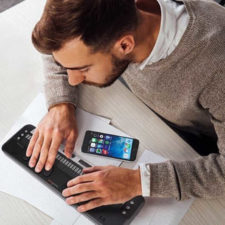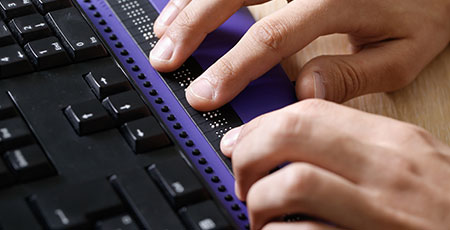Discover Cutting-edge Devices Made for the Aesthetically Impaired
The development of innovative tools for the aesthetically damaged represents a considerable advancement in accessibility and self-reliance. Technologies such as wise glasses with AI capacities and mobile applications designed to provide auditory descriptions are improving everyday experiences for customers.
Smart Glasses for Navigation

Smart glasses made for navigating are reinventing the method visually impaired individuals connect with their atmosphere. These sophisticated devices use a combination of cam innovation, expert system, and acoustic comments to offer real-time information concerning environments. By utilizing obstacle discovery systems, wise glasses can notify customers to prospective hazards, enabling much safer flexibility in both familiar and unfamiliar setups.
The integration of GPS modern technology even more enhances navigating capabilities, enabling users to obtain auditory instructions as they relocate. This hands-free method not just fosters self-reliance but additionally empowers aesthetically damaged individuals to browse urban landscapes with raised confidence. Furthermore, many wise glasses are furnished with features that determine landmarks and street indicators, providing contextual info that enhances the individual experience.
Furthermore, the development of these gadgets is continually progressing, with companies functioning to boost the accuracy of things recognition and broaden the series of navigational features. As wise glasses come to be much more easily accessible and budget-friendly, they hold the prospective to substantially change day-to-day live for visually impaired individuals. Inevitably, these cutting-edge devices represent a vital action towards inclusivity, offering boosted flexibility and a greater sense of freedom for individuals navigating the world around them.

Mobile Application for Daily Living
Exactly how can mobile applications enhance the lives of aesthetically damaged people? Mobile applications are transforming the way aesthetically damaged customers browse their atmospheres, take care of everyday tasks, and accessibility info. These applications offer important assistance via different performances, cultivating self-reliance and boosting lifestyle.
Several cutting-edge mobile apps are created specifically for everyday living. For instance, applications like Be My Eyes connect aesthetically impaired customers with sighted volunteers through video clip phone calls, allowing them to obtain real-time support with jobs such as checking out tags or browsing strange rooms. In A Similar Way, Seeing AI, established by Microsoft, utilizes expert system to explain environments, reviewed message, and identify items, effectively transforming a smart device into a powerful device for daily support.
Additionally, navigating applications customized for the visually impaired, such as Aira and BlindSquare, provide audio-based instructions and ecological information, allowing individuals to traverse their surroundings safely and confidently. Beyond navigating and prompt aid, mobile apps likewise support organization and job administration, with functions that aid individuals establish reminders, develop to-do checklists, and track appointments. In summary, mobile applications function as vital resources, empowering visually impaired individuals to lead more independent and satisfying lives.
Wearable Technologies for Help
Empowerment with modern technology is progressively noticeable in the world of wearable tools designed to assist visually damaged people. These innovative devices incorporate perfectly right into day-to-day live, enhancing navigation and giving crucial comments to customers. As an example, wise glasses geared up with cameras can identify faces and review message aloud, enabling users to connect even more confidently in social and specialist settings.
An additional remarkable improvement is making use of haptic responses systems in wearable gadgets. These systems use vibrations or other responsive signals to communicate information concerning the individual's atmosphere, such as challenges or adjustments in surface, enhancing mobility and safety and security. Wearable modern technologies also consist of wristbands that link to smartphones, informing users to alerts with subtle resonances, thus boosting connectivity without dependence on visual signs.
As these innovations remain to evolve, they are not only boosting independence for visually damaged people but additionally fostering a higher feeling of incorporation in society. By connecting the gap in between challenges dealt with in everyday living and the potential for autonomy, wearable modern technologies act as crucial tools in the mission for equality and empowerment for those with visual problems.
Audio Summary Devices
Sound description tools play a crucial duty in improving accessibility for visually damaged people, providing them with the ability to engage with visual media. Screen readers for the blind. These tools provide narrated descriptions of vital visual components in films, television programs, and live performances, guaranteeing that individuals can totally comprehend the context and emotions communicated with visuals
Sound description can be incorporated right into numerous platforms, including streaming services, movie theater testings, and live movie theater. Lots of prominent streaming services now include audio summary as an accessibility feature, allowing audiences to choose it quickly. In addition to mainstream media, specialized apps also exist, offering audio descriptions for art exhibits, museums, and other cultural events.
The efficiency of audio summary pivots on the ability of the storytellers, that should convey aesthetic details succinctly without detracting from the original audio. Developments in this area are likewise paving the means for more customized experiences, where users can readjust the level of information and pacing according to their choices.
Braille Innovations and Tools
Braille advancements and devices have actually significantly changed the way visually impaired individuals communicate with text and details. Modern developments have actually resulted in the advancement of flexible devices that boost proficiency and freedom amongst customers. Notably, Braille show modern technologies have progressed, enabling for vibrant reading experiences. These gadgets transform digital message right into Braille, allowing individuals to access a vast range of details on tablet computers, smart devices, and computers.
Additionally, portable Braille notetakers combine standard Braille input with modern performances, assisting in note-taking, scheduling, and paper modifying on the move. OCR devices for the blind. These compact devices frequently feature text-to-speech capabilities, linking the void between Braille and acoustic information
On top of that, cutting-edge Braille printers have emerged, allowing customers to generate Braille tags, files, and educational materials successfully. This access promotes higher involvement in expert and instructional environments, inevitably advertising inclusivity.
Additionally, research study into wise Braille innovations continues to increase. Tools that integrate artificial knowledge are being checked out to provide real-time navigation support and contextual info, boosting the individual experience in diverse setups. In general, these innovations mirror a commitment to encouraging visually damaged individuals through modern technology, guaranteeing they can easily accessibility and engage with the globe around them.

Final Thought
The development of cutting-edge tools for the visually damaged dramatically Braille displays and notetakers enhances independence and high quality of life. These innovations not just foster better incorporation however additionally advertise autonomy in everyday tasks, ultimately contributing to a much more accessible and fair society for visually damaged people.
As wise glasses end up being extra available and affordable, they hold the prospective to significantly change day-to-day life for aesthetically impaired customers. Mobile applications are transforming the way aesthetically impaired users browse their atmospheres, manage day-to-day jobs, and accessibility information. Apps like Be My Eyes connect visually impaired individuals with sighted volunteers through video clip phone calls, allowing them to obtain real-time support with tasks such as checking out labels or browsing unfamiliar rooms.Furthermore, navigating apps tailored for the aesthetically impaired, such as Aira and BlindSquare, use audio-based instructions and ecological information, making it possible for users to traverse their environments safely and with confidence.The development of cutting-edge tools for the aesthetically impaired substantially enhances self-reliance and top quality of life.